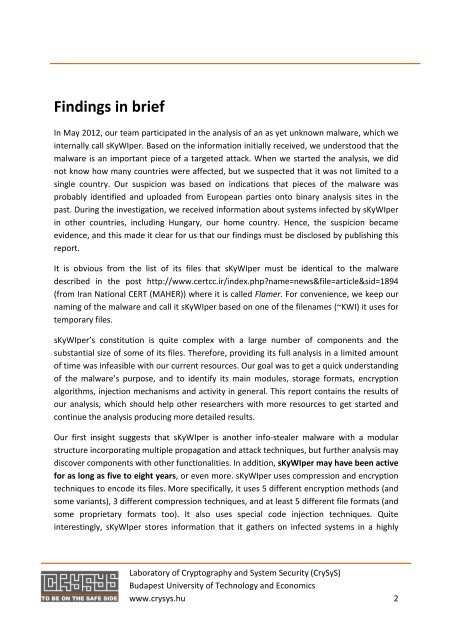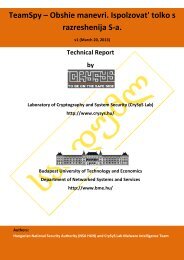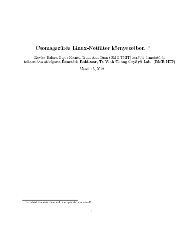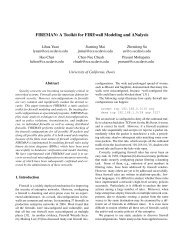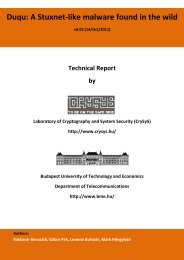sKyWIper (a.k.a. Flame a.k.a. Flamer): A complex ... - CrySyS Lab
sKyWIper (a.k.a. Flame a.k.a. Flamer): A complex ... - CrySyS Lab
sKyWIper (a.k.a. Flame a.k.a. Flamer): A complex ... - CrySyS Lab
Create successful ePaper yourself
Turn your PDF publications into a flip-book with our unique Google optimized e-Paper software.
Findings in brief<br />
In May 2012, our team participated in the analysis of an as yet unknown malware, which we<br />
internally call <strong>sKyWIper</strong>. Based on the information initially received, we understood that the<br />
malware is an important piece of a targeted attack. When we started the analysis, we did<br />
not know how many countries were affected, but we suspected that it was not limited to a<br />
single country. Our suspicion was based on indications that pieces of the malware was<br />
probably identified and uploaded from European parties onto binary analysis sites in the<br />
past. During the investigation, we received information about systems infected by <strong>sKyWIper</strong><br />
in other countries, including Hungary, our home country. Hence, the suspicion became<br />
evidence, and this made it clear for us that our findings must be disclosed by publishing this<br />
report.<br />
It is obvious from the list of its files that <strong>sKyWIper</strong> must be identical to the malware<br />
described in the post http://www.certcc.ir/index.php?name=news&file=article&sid=1894<br />
(from Iran National CERT (MAHER)) where it is called <strong>Flame</strong>r. For convenience, we keep our<br />
naming of the malware and call it <strong>sKyWIper</strong> based on one of the filenames (~KWI) it uses for<br />
temporary files.<br />
<strong>sKyWIper</strong>’s constitution is quite <strong>complex</strong> with a large number of components and the<br />
substantial size of some of its files. Therefore, providing its full analysis in a limited amount<br />
of time was infeasible with our current resources. Our goal was to get a quick understanding<br />
of the malware’s purpose, and to identify its main modules, storage formats, encryption<br />
algorithms, injection mechanisms and activity in general. This report contains the results of<br />
our analysis, which should help other researchers with more resources to get started and<br />
continue the analysis producing more detailed results.<br />
Our first insight suggests that <strong>sKyWIper</strong> is another info-stealer malware with a modular<br />
structure incorporating multiple propagation and attack techniques, but further analysis may<br />
discover components with other functionalities. In addition, <strong>sKyWIper</strong> may have been active<br />
for as long as five to eight years, or even more. <strong>sKyWIper</strong> uses compression and encryption<br />
techniques to encode its files. More specifically, it uses 5 different encryption methods (and<br />
some variants), 3 different compression techniques, and at least 5 different file formats (and<br />
some proprietary formats too). It also uses special code injection techniques. Quite<br />
interestingly, <strong>sKyWIper</strong> stores information that it gathers on infected systems in a highly<br />
<strong>Lab</strong>oratory of Cryptography and System Security (<strong>CrySyS</strong>)<br />
Budapest University of Technology and Economics<br />
www.crysys.hu 2


